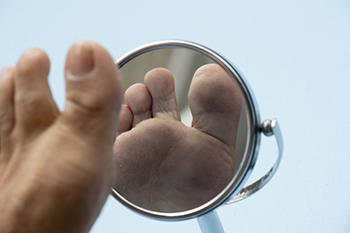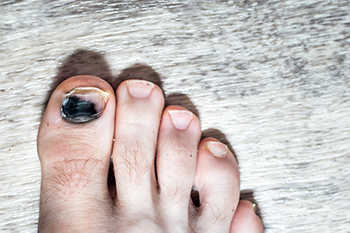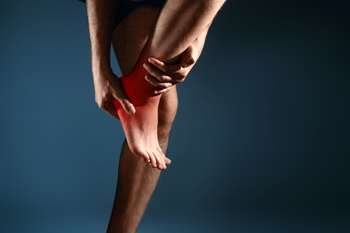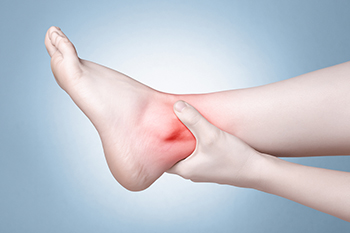Items filtered by date: September 2025
Understanding the Differences in Foot Wounds

Not all foot wounds are the same, and knowing the difference can guide proper care. Arterial wounds often develop when blood flow to the feet is poor. These wounds are usually painful, may appear on the toes or heels, and often have a pale or punched out look. Venous wounds occur when veins are not moving blood efficiently back to the heart. These are commonly found around the ankles, may be less painful, and often appear with swelling or discoloration of the skin. Neurotrophic wounds, often linked to diabetes or nerve damage, may form on pressure points of the feet. Because sensation is reduced, these wounds can develop unnoticed and worsen over time. wound type has distinct causes and needs special attention. If you notice any foot or ankle wound that is not healing, it is suggested that you consult a podiatrist for evaluation and appropriate treatment.
Wound care is an important part in dealing with diabetes. If you have diabetes and a foot wound or would like more information about wound care for diabetics, consult with David K. Morris, DPM from Florida. Our doctor will assess your condition and provide you with quality foot and ankle treatment.
What Is Wound Care?
Wound care is the practice of taking proper care of a wound. This can range from the smallest to the largest of wounds. While everyone can benefit from proper wound care, it is much more important for diabetics. Diabetics often suffer from poor blood circulation which causes wounds to heal much slower than they would in a non-diabetic.
What Is the Importance of Wound Care?
While it may not seem apparent with small ulcers on the foot, for diabetics, any size ulcer can become infected. Diabetics often also suffer from neuropathy, or nerve loss. This means they might not even feel when they have an ulcer on their foot. If the wound becomes severely infected, amputation may be necessary. Therefore, it is of the upmost importance to properly care for any and all foot wounds.
How to Care for Wounds
The best way to care for foot wounds is to prevent them. For diabetics, this means daily inspections of the feet for any signs of abnormalities or ulcers. It is also recommended to see a podiatrist several times a year for a foot inspection. If you do have an ulcer, run the wound under water to clear dirt from the wound; then apply antibiotic ointment to the wound and cover with a bandage. Bandages should be changed daily and keeping pressure off the wound is smart. It is advised to see a podiatrist, who can keep an eye on it.
If you have any questions please contact our office located in Plantation, FL . We offer the newest diagnostic and treatment technologies for all your foot and ankle needs.
Heel Pain in the Morning?
The Causes of Ticklish Feet

Ticklish feet are a common sensation that can make some people laugh uncontrollably, while others may find it uncomfortable. The sensitivity in the feet is due to the presence of approximately 8,000 nerve endings that respond to various stimuli. The sensation of tickling can be broken down into two types, which are known as knismesis and gargalesis. Knismesis refers to a light, often gentle touch that can cause itching or mild tickling sensations, while gargalesis is a more intense form of tickling that often results in laughter and can trigger an involuntary response. People vary in their sensitivity to tickling, as factors such as genetic makeup, nervous system sensitivity, and psychological aspects play a role. The feet are particularly sensitive due to their high concentration of nerve endings, which makes them more susceptible to ticklish sensations when touched or stimulated. Ticklish feet can be bothersome while having pedicures performed or getting foot massages. It may also indicate diabetes. If you have particularly sensitive feet, it is suggested that you consult a podiatrist who can educate you on this condition.
Foot Pain
Foot pain can be extremely painful and debilitating. If you have a foot pain, consult with David K. Morris, DPM from Florida. Our doctor will assess your condition and provide you with quality foot and ankle treatment.
Causes
Foot pain is a very broad condition that could be caused by one or more ailments. The most common include:
- Bunions
- Hammertoes
- Plantar Fasciitis
- Bone Spurs
- Corns
- Tarsal Tunnel Syndrome
- Ingrown Toenails
- Arthritis (such as Gout, Rheumatoid, and Osteoarthritis)
- Flat Feet
- Injury (from stress fractures, broken toe, foot, ankle, Achilles tendon ruptures, and sprains)
- And more
Diagnosis
To figure out the cause of foot pain, podiatrists utilize several different methods. This can range from simple visual inspections and sensation tests to X-rays and MRI scans. Prior medical history, family medical history, and any recent physical traumatic events will all be taken into consideration for a proper diagnosis.
Treatment
Treatment depends upon the cause of the foot pain. Whether it is resting, staying off the foot, or having surgery; podiatrists have a number of treatment options available for foot pain.
If you have any questions, please feel free to contact our office located in Plantation, FL . We offer the newest diagnostic and treatment technologies for all your foot care needs.
Causes and Treatment of Black Toenail

A black toenail can be concerning because it may develop from a variety of causes, ranging from trauma to underlying health issues. The most common cause of a blackened toenail is injury. Stubbing the toe or repeated pressure from shoes can trap blood under the nail and cause it to darken. Runners often experience this type of injury, sometimes called runner’s toe. Discoloration may also signal a fungal infection, where organisms thrive under the nail and can lead to thickening or brittleness. Ingrown toenails or bacterial infections can cause similar toenail changes. Medical conditions like diabetes, circulation problems, or even vitamin deficiencies may also contribute to nail darkening. Rarely, melanoma, a form of skin cancer, may appear as a dark streak under the toenail. A podiatrist can examine the toenail and order appropriate tests. Treatment may involve draining trapped blood, addressing infection, or, in severe cases, surgery. If you notice discoloration of a toenail, it is suggested that you schedule an appointment with a podiatrist for an evaluation and appropriate treatment.
Toe pain can disrupt your daily activities. If you have any concerns, contact David K. Morris, DPM of Florida. Our doctor can provide the care you need to keep you pain-free and on your feet.
What Causes Toe Pain?
Most severe toe pain is caused due to a sports injury, trauma from dropping something heavy on the toe, or bumping into something rigid. Other problems can develop over time for various reasons.
Toe pain can be caused by one or more ailments. The most common include:
- Trauma
- Sports injury
- Wearing shoes that are too tight
- Arthritis
- Gout
- Corns and calluses
- Hammertoe
- Bunions
- Blisters
- Ingrown toenails
- Sprains
- Fractures (broken bones)
- Dislocations
When to See a Podiatrist
- Severe pain
- Persistent pain that lasts more than a week
- Signs of infection
- Continued swelling
- Pain that prevents walking
Diagnosis
In many cases the cause of toe pain is obvious, but in others, a podiatrist may want to use more advanced methods to determine the problem. These can range from simple visual inspections and sensation tests to X-rays and MRI scans. Prior medical history, family medical history, and any recent physical traumatic events will all be taken into consideration for a proper diagnosis.
Treatment
Treatments for toe pain and injuries vary and may include shoe inserts, padding, taping, medicines, injections, and in some cases, surgery. If you believe that you have broken a toe, please see a podiatrist as soon as possible.
If you have any questions please contact our office located in Plantation, FL . We offer the newest diagnostic and treatment technologies for all your foot and ankle needs.
Reasons You Might Have Heel Pain

Heel pain can interfere with daily activity and mobility. In many cases, heel pain develops from overuse, repetitive stress, or wearing footwear that lacks adequate support. Running on hard surfaces, sudden increases in activity, or tightness in the calf muscles and Achilles tendon can also contribute to this type of pain. Injuries, such as a heel bone fracture from a fall or hard landing, may also be factors. Conditions including plantar fasciitis, bursitis, Achilles tendon inflammation, or the growth of bone spurs can further lead to tenderness, stiffness, and swelling at the heel. Pain may be felt under the heel, at the back of the heel, or along the Achilles tendon, depending on the underlying cause. A podiatrist can provide a full evaluation, offer proper treatment, and determine whether imaging or surgery may be needed. If you are experiencing heel pain, it is suggested that you schedule an appointment with a podiatrist for a diagnosis and appropriate treatment.
Many people suffer from bouts of heel pain. For more information, contact David K. Morris, DPM of Florida. Our doctor can provide the care you need to keep you pain-free and on your feet.
Causes of Heel Pain
Heel pain is often associated with plantar fasciitis. The plantar fascia is a band of tissues that extends along the bottom of the foot. A rip or tear in this ligament can cause inflammation of the tissue.
Achilles tendonitis is another cause of heel pain. Inflammation of the Achilles tendon will cause pain from fractures and muscle tearing. Lack of flexibility is also another symptom.
Heel spurs are another cause of pain. When the tissues of the plantar fascia undergo a great deal of stress, it can lead to ligament separation from the heel bone, causing heel spurs.
Why Might Heel Pain Occur?
- Wearing ill-fitting shoes
- Wearing non-supportive shoes
- Weight change
- Excessive running
Treatments
Heel pain should be treated as soon as possible for immediate results. Keeping your feet in a stress-free environment will help. If you suffer from Achilles tendonitis or plantar fasciitis, applying ice will reduce the swelling. Stretching before an exercise like running will help the muscles. Using all these tips will help make heel pain a condition of the past.
If you have any questions, please feel free to contact our office located in Plantation, FL . We offer the newest diagnostic and treatment technologies for all your foot care needs.
Os Trigonum Syndrome and How It Affects the Ankle

Os trigonum syndrome is a painful condition that occurs when an extra bone at the back of the ankle, called the os trigonum, becomes irritated. This small piece of bone is present in some people and usually does not cause problems. However, repetitive ankle movement, such as pointing the toes during ballet, soccer, or running, can trap this bone between the heel and ankle, leading to pain and swelling. Symptoms often include deep aching at the back of the ankle, tenderness when pressing on the area, and discomfort that worsens with activity. It may be mistaken for other ankle injuries, which is why an accurate diagnosis from a podiatrist is important. Treatment includes rest, anti-inflammatory medication, targeted exercise, or supportive footwear. In more severe cases, surgery to remove the os trigonum can relieve pain and restore ankle function. If you have pain or swelling at the back of your ankle, it is suggested that you schedule an appointment with a podiatrist for a diagnosis and proper treatment.
Ankle pain can have many different causes and the pain may potentially be serious. If you have ankle pain, consult with David K. Morris, DPM from Florida. Our doctor will assess your condition and provide you with quality foot and ankle treatment.
Ankle pain is any condition that causes pain in the ankle. Due to the fact that the ankle consists of tendons, muscles, bones, and ligaments, ankle pain can come from a number of different conditions.
Causes
The most common causes of ankle pain include:
- Types of arthritis (rheumatoid, osteoarthritis, and gout)
- Ankle sprains
- Broken ankles
- Achilles tendinitis
- Achilles tendon rupture
- Stress fractures
- Tarsal tunnel syndrome
- Plantar fasciitis
Symptoms
Symptoms of ankle injury vary based upon the condition. Pain may include general pain and discomfort, swelling, aching, redness, bruising, burning or stabbing sensations, and/or loss of sensation.
Diagnosis
Due to the wide variety of potential causes of ankle pain, podiatrists will utilize a number of different methods to properly diagnose ankle pain. This can include asking for personal and family medical histories and of any recent injuries. Further diagnosis may include sensation tests, a physical examination, and potentially x-rays or other imaging tests.
Treatment
Just as the range of causes varies widely, so do treatments. Some more common treatments are rest, ice packs, keeping pressure off the foot, orthotics and braces, medication for inflammation and pain, and surgery.
If you have any questions please feel free to contact our office located in Plantation, FL . We offer the newest diagnostic tools and technology to treat your foot and ankle needs.




